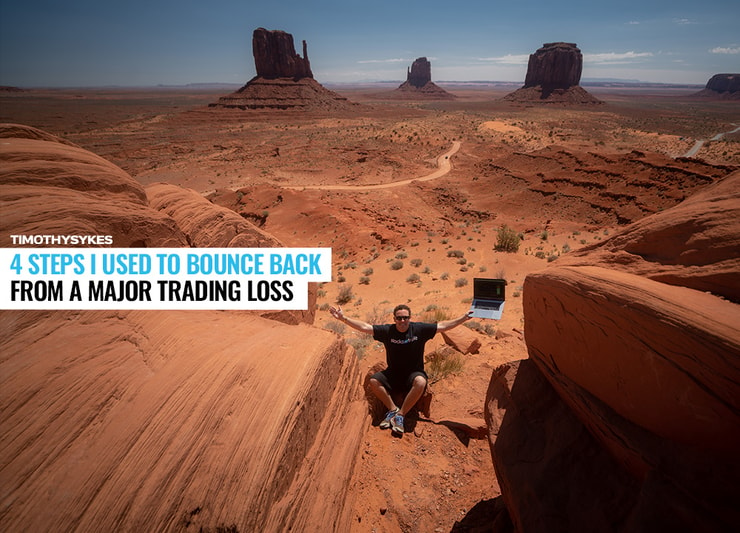Every trader knows that crushing feeling.
The weight on your chest when a single trade erases weeks, if not months, of hard work.
On May 26th, that was me—a staggering $27K loss in the ticker symbol EFTR.
It felt like I’d been sucker-punched.
Doubt crept in.
But here’s the thing…I would either learn from it or dive into a deeper hole.
I clawed my way back, turning the crushing loss into a $31K gain in just a few months…
Moreover, I’m up over $25K in the last two months.
If you’ve ever found yourself in a hole, listen up.
I’m about to share the four steps I took to recover from my stunning loss.
These four steps were my lifeline. And they could be yours too.
Table of Contents
Step One: Slow Down

After taking a big loss, you naturally want to “get it back.”
The aftermath of a substantial trading loss often induces a whirlwind of emotions, from frustration and anger to desperation and anxiety.
It’s a psychological minefield. It’s natural to want to jump back in, fueled by the burning desire to recoup what you’ve lost.
But this reactive mindset, clouded by emotions, can be a recipe for further mistakes and even bigger losses.
I immediately put myself in “time out.”
I took a step back to analyze what went wrong objectively and assessed my trading strategy.
By slowing down, I allowed myself to trade with a clear mind and an analytical perspective rather than being driven by raw emotion.
Don’t get me wrong, this sucks. And it requires tremendous discipline.
But if you approach trading as a marathon and not a sprint, it can help.
A Common Mistake New Traders Make 🚫 💡@timothysykes pic.twitter.com/ODKZSE1Iyg
— StocksToTrade (@StocksToTrade) August 31, 2023
Step Two: Focus On Your Best Setups

It pays to do your homework.
Despite my long-term success, I still journal and review my trades.
Why?
It keeps me sharp.
If you review your trades then you know exactly what’s working and what isn’t.
For me, the focus has been panic dip buying on highly shorted stocks.
For example, last Friday, I saw a big crack in the crazy pre-morning spiker, EDBL.

The stock was as high as $4.48 in the pre-market…
I missed a few earlier chances to get in, so I patiently waited for a panic below $3.
I like whole numbers because I feel like that’s where many newbies will set their stops.
The algo traders know this… and push it down, get all the stops to hit, and then spike it back up.
I entered at $2.92 and got out at $3.23.
Looking back at my previous successful trades, I know this setup works well for me.
Now, I’m not saying it will always work. I have mastered several strategies throughout the years…some work better than others.
It all depends on the current market conditions—another reason you must constantly study.
Step Three: Cut Losses Quickly

You can’t afford another big loss when you’re in the hole.
Cutting losses quickly allows you two things.
First, find your rhythm after a trading slump.
In that first month and a half, I made around $5K.
I was trading super small, not focused on profits, but finding my rhythm.
Since July, I’ve been feeling better and getting a good read on the markets.
I’m slowly feeling ready to start putting on bigger trades.
None of this would be possible if I didn’t cut losses quickly.
Not only does it buy you time to find your rhythm, but it also puts less pressure to hit big winners.
Step Four: Let The Action Come To You

You got a better chance at finding Waldo than finding me…
That’s how crazy my travel schedule is.
Gooooooooooooooooooooooooooooooooooooooooooooooooooooooooooooooooooooooooooooooooooooood morning and #HappyLaborDay 2023! Remember the #StockMarket is closed today for #LaborDay so you have more time to prepare and STUDYYYYYYY HAAAAAARD…even if you’re in an underwater hotel! pic.twitter.com/Ok3JfSMAGN
— Timothy Sykes (@timothysykes) September 4, 2023
I might not always be in a location that has good wifi, so I have to be extremely careful about the trades I place.
Over the years I’ve adopted the mentality of acting like a retired trader…that is…act like I’m retired…and only jump back into the market if I’m super compelled.
In other words, I see a setup so good, I would kick myself for not taking it.
And that’s how I traded last Friday.
For example, I spotted the ticker symbol MEDS and saw a beautiful dip buying opportunity.
It was trading above $15.70 in the pre-market…but I waited for the panic.

I got my entry at $10.85 and was out at $11.48.
It’s been rinse and repeat lately with these plays.
And that’s how good trading should be.
It shouldn’t be hard or stressful.
You should let the action come to you.
Bonus Step 5: Elevate Your Trading with Expert Insights

Sometimes, the best way to accelerate recovery and leapfrog your progress is by tapping into the expertise of those who’ve walked the path.
Trading, like any skill, is best learned with a mix of personal experience and mentorship.
Here’s the thing: you don’t have to do it all alone.
Whether you’re trying to bounce back from a loss, or just looking to sharpen your edge in the market, a deeper understanding and fresh perspectives can make all the difference.
That’s why my team and I host exclusive live training workshops.
We deep dive into current market trends, dissect notable trades, and, most importantly, share actionable strategies that can be a game changer for you.
And the best part? We’re offering this invaluable experience at no cost to you. All you need is to show up, listen, and apply.
Ready to transform your trading journey?
CLICK HERE TO JOIN OUR UPCOMING LIVE TRAINING SESSION.
Dive deeper, trade smarter.
Your breakthrough might just be one session away.



Leave a reply